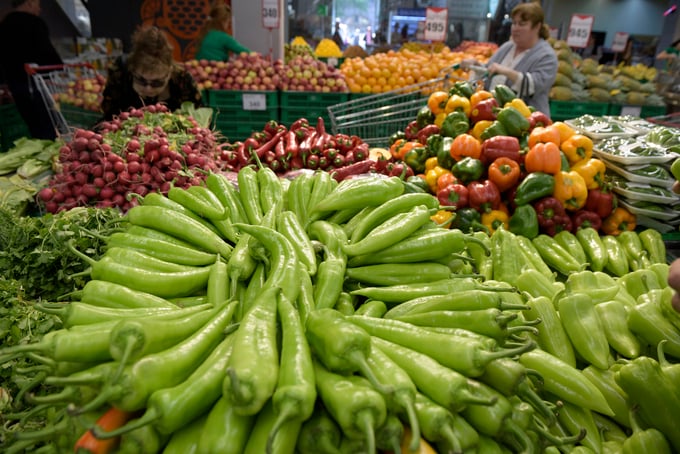November 24, 2025 | 07:00 GMT +7
November 24, 2025 | 07:00 GMT +7
Hotline: 0913.378.918
November 24, 2025 | 07:00 GMT +7
Hotline: 0913.378.918

A fresh produce market.
Knowing how value is distributed through the world’s agrifood systems would make it a lot easier to optimize and transform them.
To contribute to the evidence base required, the Food and Agriculture Organization of the United Nations (FAO) is developing a new data set to track how resources flow across the economy and assess how many of them end up in the agricultural sector.
The new Food Value Chain domain is now available on the FAOSTAT portal. It aims to break down the national food expenditures by final consumers through the different stages of the agrifood value chains, following the “Food Dollar” approach pioneered by the Economic Research Service (ERS) of the United States Department of Agriculture (USDA). FAO, the Cornell University and the ERS have joined forces to adapt and scale up the USDA approach, with an eye to better understanding the magnitude of the role played by post-harvest food value chain intermediation such as processing, storage, transport and wholesaling.
The new FAOSTAT domain, which will steadily expand coverage, has information for 65 countries from 2005 through 2015. It shows that around 20 percent of expenditure on food at home accrues to the farmer, around one-fourth to processing, and nearly half to retail and wholesale trade.
Meanwhile, only around 6.7 percent of consumer expenditure on food away from home accrues to the farmer. That figure is steadily decreasing even, highlighting the need to pay attention to the post farm-gate dimension of the food value chains.
By comparison, farmers in the United States of America earned 14.5 cents for every consumer dollar spent on domestically produced foods, and six cents on each dollar spent on food away from home. [BV(1]
Consistent data of this sort is key, among other policy agendas, for the strategic analysis of the capacity to generate employment within the entire agrifood system.
The new FAOSTAT domain marks an important and complex shift towards moving statistical collection and analysis from a focus on the agriculture sector to agrifood systems at large, said Jose Rosero Moncayo, head of the FAO’s Statistics Division. Another example is the pathbreaking work FAOSTAT is doing on greenhouse gas emissions across the farm to form spectrum.
Making sense of the data
The farmer’s share for food away from home, the most dynamic sector of agrifood systems, varies significantly around the world, from less than 0.5 percent in Singapore to 25 percent in India.
“Typically, as you grow richer, supermarkets and food processors gain a lot of power vis-à-vis farmers, and this data illustrates that,” said Statistics Deputy Director Piero Conforti.
In fact the share accruing to farmers is a starting point to gain main insights. For example, the farm share of the food dollar can be higher where agriculture produces a lot of high-value fruits and horticultural products. And if the farm share declines because of overall economic development in a country, that can be a welcomed development, which will likely boost the value of farm inputs to food away from home as people have higher willingness to pay.
The current dataset will steadily be updated and broadened to more countries, fetching more data that is made available around the world. At the moment, the dataset necessarily includes broad categories that can encompass exogenous elements such as tobacco, while most current measurements of the share of food away from home include accommodation or leisure charges.
Despite coverage limitations and inevitable time lags for now, the opening of the domain marks a significant step forward in taking a wider point of view, one that embraces the process leading from primary production to food consumption as a whole.
(FAO.org)

(VAN) In Brazil, FAO unveiled a series of reports and initiatives showing how sustainable agrifood systems are a solution to the climate crisis.

(VAN) With names like neodymium and dysprosium, rare-earth elements sound exotic — and their perceived scarcity has only added to the mystique.

(VAN) In a new study published in Trends in Biotechnology, researchers used a gene-editing technology called CRISPR to increase a fungus's production efficiency and cut its production-related environmental impact by as much as 61%- all without adding any foreign DNA.

(VAN) A top official in Beijing’s Cop delegation says China is committed to clean energy – but US’s absence is a problem.

(VAN) The Bangsamoro region’s inflation rate rose slightly to –1.3 percent in October 2025 from –1.5 percent in September, the Philippine Statistics Authority (PSA-BARMM) reported.

(VAN) FAO-led report says protecting and restoring forests is crucial to boosting climate-resilient agriculture, rural livelihoods and global food and water security.

(VAN) Flagship partnership secures additional GBP 16.9 million to strengthen forest monitoring, transparency and country support to 2030.